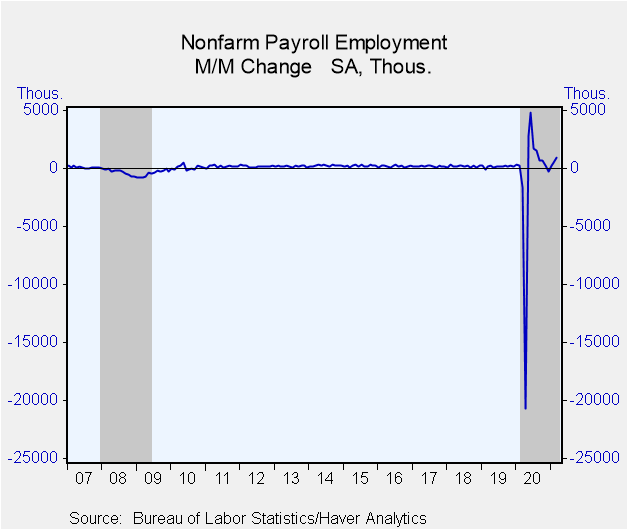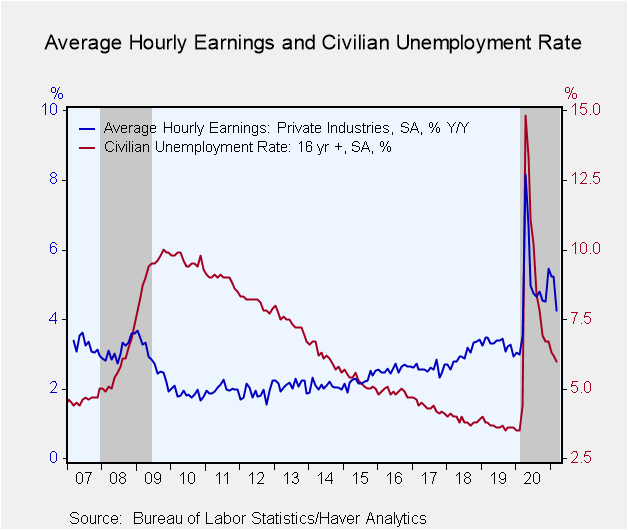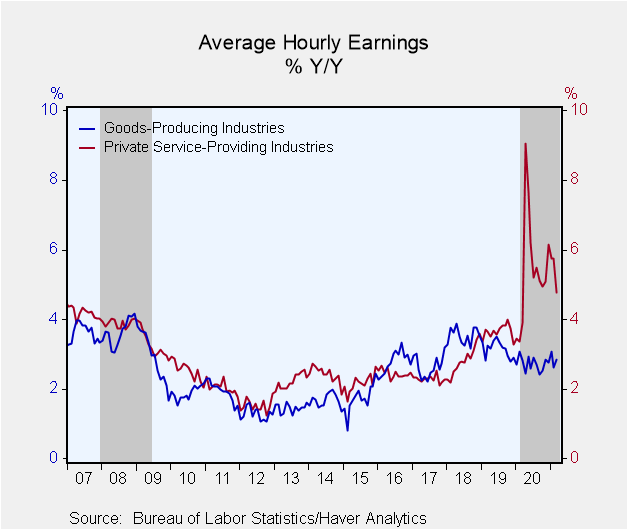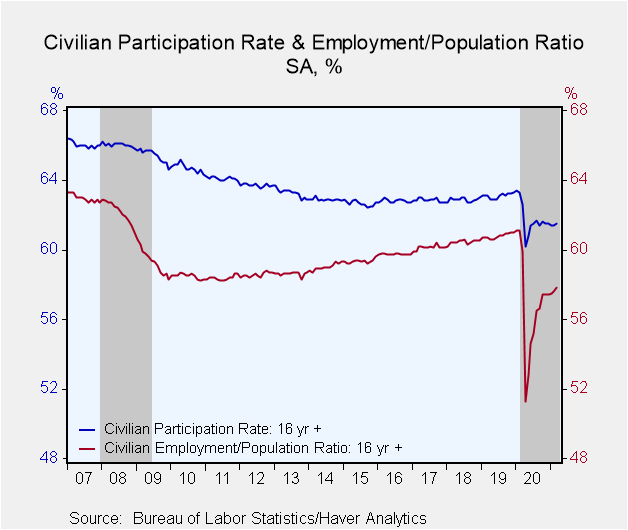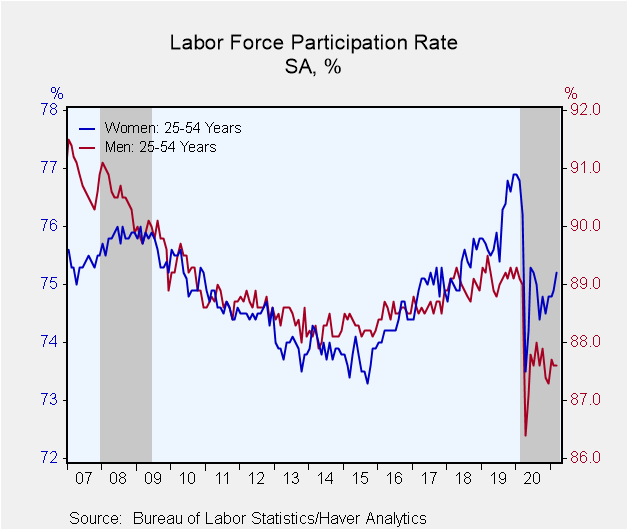 Global| Apr 02 2021
Global| Apr 02 2021U.S. Payrolls are Unexpectedly Strong in March; Unemployment Rate Declines
by:Tom Moeller
|in:Economy in Brief
Summary
• Leisure & hospitality plus construction drive jobs strength. • Average hourly earnings slip. • Unemployment rate declines to lowest level in twelve months. The labor market has revived with business re-openings following [...]
• Leisure & hospitality plus construction drive jobs strength.
• Average hourly earnings slip.
• Unemployment rate declines to lowest level in twelve months.
The labor market has revived with business re-openings following restrictions due to COVID-19. Nonfarm payroll employment strengthened 916,000 (-4.4% y/y) in March after rising 468,000 during February, revised from 379,000. The January gain of 233,000 also was revised higher from 166,000. A 613,000 increase in March had been expected in the Action Economic Forecast Survey. The forecast estimates of the March payroll change ranged from 280,000 to 961,000 amongst 26 forecasters.
Average hourly earnings eased 0.1% (+4.2% y/y) last month compared to a 0.3% February rise, revised from 0.2%. A 0.1% gain in March had been expected.
The unemployment rate declined to an expected 6.0% from 6.2% in February. Employment in the household survey rose 609,000 (-3.0% y/y) after increasing 208,000 in February while the labor force strengthened 347,000 (-1.3% y/y) after gaining 50,000 in February. The overall jobless rate, including those who were marginally attached or working part-time for economic reasons, fell to 10.7% from 11.1% and was below the 22.9% high reached in April of last year.
From the payroll survey of employment, the 916,000 increase in jobs was the strongest since August. Construction sector employment rose 110,000 (-1.1% y/y). Factory sector jobs increased 53,000 (-3.3% y/y) while mining & logging sector jobs rose 20,000 (-9.1% y/y).
Private service employment strengthened 597,000 (-4.6% y/y), about as it did in February. The gain was led by a 280,000 increase (-14.4% y/y) in leisure & hospitality employment which included a 215,900 surge (-12.6% y/y) in hotel & restaurant jobs. Education & health services hiring rose 101,000 (-3.9% y/y) while employment in trade, transportation & utilities gained 94,000 (-1.9% y/y). Professional & business services employment rose 66,000 (-2.4% y/y). Financial sector employment rose 16,000 (-0.6% y/y) but information jobs fell 2,000 (-7.6% y/y).
Government sector employment bounced back 136,000 last month (-5.0% y/y) following a 90,000 February decline. Local government employment rose 83,000 (-6.2% y/y) while state governments added 46,000 jobs (-4.5% y/y). Federal government hiring improved 7,000 after two months of decline and was unchanged y/y.
The 0.1% slip in average hourly earnings reflected a 0.2% decline (+4.7% y/y) in private service sector earnings. Information sector earnings declined 1.7% (+1.4% y/y) while education & health care pay declined 0.6% (+4.0% y/y). These declines were offset by a 1.5% rise (4.6% y/y) in leisure & hospitality earnings which followed a 1.0% February jump. Professional & business services earnings improved 0.1% (3.8% y/y).
 The length of the average workweek extended to 34.9 hours, up
from 34.1 hours last March. Mining & logging hours grew to 45.6 while
factory sector hours rose to 40.5. Construction sector hours rose to 39.6.
Private service sector hours rose to 33.8, reflecting an extension in leisure
& hospitality hours to 26.0, the most since October. Financial sector hours
were stable at 37.7, while professional & business service sector hours held
at 36.8 hours.
The length of the average workweek extended to 34.9 hours, up
from 34.1 hours last March. Mining & logging hours grew to 45.6 while
factory sector hours rose to 40.5. Construction sector hours rose to 39.6.
Private service sector hours rose to 33.8, reflecting an extension in leisure
& hospitality hours to 26.0, the most since October. Financial sector hours
were stable at 37.7, while professional & business service sector hours held
at 36.8 hours.
From the household employment survey, the reduced unemployment rate of 6.0% in March occurred as the labor force participation rate edged up to 61.5%, though it remained below the 63.4% high in January of last year. The teenage participation rate eased to 35.9% but for individuals aged 20-24, it rose to 70.3%. For workers aged 25-54, the rate edged higher to 81.3% but remained below the January 2020 high of 83.0%. For men aged 25-54, the rate held at 87.6% and remained down from the high of 89.5% in March of 2019. For women of that age, the rate moved higher to 75.2% but remained well below the record high of 76.9% in January of last year. For workers aged 55 & over, the participation rate fell to 38.2%, down from the July 2019 high of 40.5 hours.
The employment/population ratio for all workers rose to 57.8% in March. It nevertheless remained well below the February 2020 high of 61.1%. The average duration of unemployment surged to 29.7 weeks, the longest in roughly six years.
The teenage unemployment rate fell to 13.0% from 13.9% in February and remained below the record 32.1% last April. The rate for workers aged 20-24 rose slightly to 10.3%. For workers aged 25-54, the rate slipped to 5.5%, down from the 12.8% April high. For those over 55, the jobless rate fell sharply to 4.5% and was well below the record 13.6% in April.
By educational attainment, the rate of unemployment of workers without a high school diploma fell sharply to 8.2% from 10.1% and remained well below the 21.0% rate in April. High school graduates without any college were 6.7% unemployed last month, down from April's high of 17.3%. That remained higher than the 3.5% rate in February 2020. Those with some college but no degree were a steady 5.9% unemployed, down sharply from the 15.0% April peak but still up from January 2020's record low of 2.7%. College graduates saw their unemployment rate cut to 3.7% last month, still significantly higher than their 1.9% low in February of last year.
The employment & earnings data are collected from surveys taken each month during the week containing the 12th of the month. The labor market data are contained in Haver's USECON database. Detailed figures are in the EMPL and LABOR databases. The expectations figures are in the AS1REPNA database.
| Employment (SA, M/M Change, 000s) | Mar | Feb | Jan | Mar Y/Y | 2020 | 2019 | 2018 |
|---|---|---|---|---|---|---|---|
| Payroll Employment | 916 | 468 | 233 | -4.4% | -5.8% | 1.3% | 1.6% |
| Previous Estimate | -- | 379 | 166 | -- | -- | -- | -- |
| Manufacturing | 53 | 18 | -18 | -3.3 | -5.0 | 1.0 | 2.0 |
| Construction | 110 | -56 | 12 | -1.1 | -3.0 | 2.8 | 4.6 |
| Private Service-Producing | 597 | 602 | 129 | -4.6 | -6.6 | 1.4 | 1.5 |
| Government | 136 | -90 | 111 | -5.0 | -3.1 | 0.7 | 0.5 |
| Average Weekly Hours - Private Sector | 34.9 | 34.6 | 35.0 | 34.1 | 34.6 | 34.4 | 34.5 |
| Private Sector Average Hourly Earnings (%) | -0.1 | 0.3 | 0.0 | 4.2 | 4.8 | 3.3 | 3.0 |
| Unemployment Rate (%) | 6.0 | 6.2 | 6.3 | 4.4 | 8.1 | 3.7 | 3.9 |
Tom Moeller
AuthorMore in Author Profile »Prior to joining Haver Analytics in 2000, Mr. Moeller worked as the Economist at Chancellor Capital Management from 1985 to 1999. There, he developed comprehensive economic forecasts and interpreted economic data for equity and fixed income portfolio managers. Also at Chancellor, Mr. Moeller worked as an equity analyst and was responsible for researching and rating companies in the economically sensitive automobile and housing industries for investment in Chancellor’s equity portfolio. Prior to joining Chancellor, Mr. Moeller was an Economist at Citibank from 1979 to 1984. He also analyzed pricing behavior in the metals industry for the Council on Wage and Price Stability in Washington, D.C. In 1999, Mr. Moeller received the award for most accurate forecast from the Forecasters' Club of New York. From 1990 to 1992 he was President of the New York Association for Business Economists. Mr. Moeller earned an M.B.A. in Finance from Fordham University, where he graduated in 1987. He holds a Bachelor of Arts in Economics from George Washington University.


